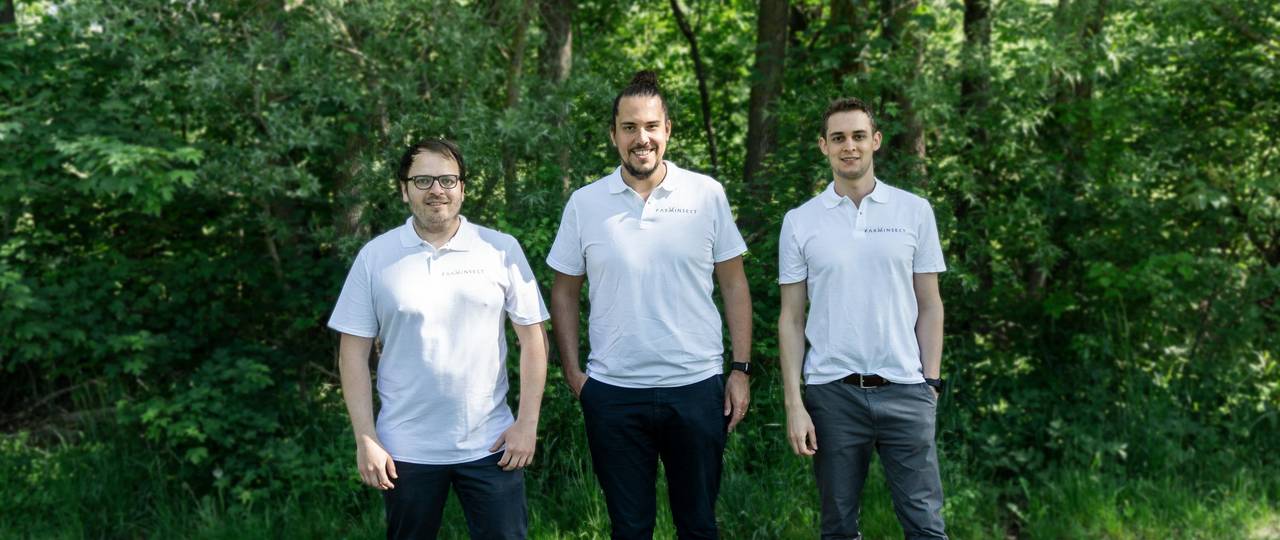
In livestock breeding, traditional feed is mainly composed of maize grain and concentrated feed from soybean extract meal, rapeseed meal extract, and grain stillage from wheat and barley. Fish meal is also fed to a certain extent. All these ingredients are intended to supply animals with enough protein to manage breeding stock. Wolfgang Westermeier, Thomas Kühn, and Andre Klöckner, graduates of the Technical University of Munich (TUM), have now developed technology with their start-up FarmInsect that can replace the more traditional sorts of protein-rich feed.
Following the principle devised by FarmInsect, residual waste from the region, such as crop or peel scraps from an agricultural company or waste from the local food industry (for example, brewer’s dregs or old bread) can be fed to insect larvae to fatten them up. This saves both up to 50% on CO2 emissions and expenses. Feeding live insects to chickens, pigs, and fish is permitted by law. As is the use of insect meal in aquaculture. Approval of this type of feed for poultry and pigs is expected in 2021.
“Our decentralized method of insect production enables the larvae to be fed while alive because there are no longer any lengthy transport routes,” says co-founder and agricultural scientist Wolfgang Westermeier. “This encourages the animals to better indulge their natural instincts of pecking and foraging. This consequently improves animal welfare.”
Local ingredients for on-site feed for animals
FarmInsect supplies equipment for insect breeding. This can be integrated modularly into the infrastructure of any animal breeding farm, the inventors explain. “The most difficult thing to do is to turn eggs into young larvae,” says Thomas Kühn. He is managing director and co-founder of FarmInsect. The company breeds the young larvae of the “particularly undiscriminating and robust” black soldier fly at its own facility. These are then delivered to farms as needed.

The young larvae grow up to 1.5 centimeters in size. They then increase their weight by a factor of 1,000 within one week inside the climate chamber, FarmInsect claims. All that is needed to produce the insect feed is to fill a mixing tank with biomass and to load the climate chamber with young larvae and unload it with adult larvae. The larvae can be used directly as feed. Mainly to fish at the moment. But also to chickens or pigs in the future probably.
Own IT platform for tracking sources
“When using regional residual waste as animal feed, the stringent rules stipulated for feed safety regulations must be complied with,” stresses co-founder Andre Klöckner. He is responsible for technical development and programming. A key challenge is the ability to fully track its source. “We have developed an IT platform in order to document this.”
As of April 2020, FarmInsect is funded by the Bavarian Ministry of Agriculture and the European Union (EU) within the framework of the program “European Innovation Partnerships.” The start-up was included in the EIT Food Accelerator Network of the EU in the summer of 2020 as one of the most promising food and agritech start-ups in Europe.
In a few weeks’ time, FarmInscet will start up a pilot plant at one of the largest aquaculture companies in Bavaria, Germany.
Title photo: TUM graduates Wolfgang Westermeier, Thomas Kühn and Andre Klöckner set up the start-up FarmInsect.. © FarmInsect

